Compassion at Work: Effective Employment Termination Letters + 22 Templates
“Employment Termination Letters” is your one-stop destination for understanding the intricacies of employment terminations. We recognize that decisions can be difficult and sensitive for employers and employees alike. This website serves as a valuable resource to help you navigate processes with professionalism, empathy, and compliance with legal requirements. Our goal is to equip employers with essential insights, best practices, and legal considerations to conduct fair and respectful terminations. Whether you’re dealing with poor performance, restructuring, or other reasons, we are here to provide guidance that fosters a supportive work environment during periods of change. Let us empower you to make informed decisions and uphold the well-being of all parties involved during employment terminations.
Legal Considerations in Employment Terminations:
When conducting employment terminations, employers must carefully navigate various legal considerations to avoid potential legal disputes and ensure compliance with relevant employment laws and regulations. Here are some key legal aspects to keep in mind:
- At-Will Employment:
- Understand the concept of “at-will” employment, which allows employers and employees to terminate the employment relationship at any time, with or without cause, and without notice.
- Note that exceptions to at-will employment may apply in certain jurisdictions, such as implied employment contracts or collective bargaining agreements.
- Employment Laws:
- Familiarize yourself with federal, state, and local employment laws that govern procedures and employee rights during termination.
- Comply with laws related to wrongful termination, discrimination, harassment, retaliation, and the Worker Adjustment and Retraining Notification (WARN) Act for large-scale layoffs.
- Contractual Obligations:
- Review any employment contracts or collective bargaining agreements that may govern the terms and conditions of employment.
- Ensure compliance with contractually agreed-upon procedures and notice requirements.
- Severance Agreements:
- If offering a severance package, create a written severance agreement that clearly outlines the terms, benefits, and conditions for receiving the severance pay.
- Consult with legal counsel when designing severance agreements to ensure they comply with employment laws and minimize potential risks.
- Discrimination and Retaliation:
- Avoid terminating employees based on protected characteristics, such as race, gender, religion, age, disability, or national origin.
- Do not retaliate against employees for engaging in protected activities, such as whistleblowing or reporting workplace violations.
- Proper Documentation:
- Maintain comprehensive documentation of performance issues, disciplinary actions, and the reasons for termination to demonstrate a legitimate, non-discriminatory basis for the decision.
- Accurate and detailed records can help defend the company against potential legal challenges.
- Notice Periods:
- Be aware of any legal requirements for providing advance notice to employees before termination, especially in cases of mass layoffs or plant closures.
- Adhere to notice requirements to avoid legal consequences and ensure fairness to affected employees.
- Non-Compete and Non-Disclosure Agreements:
- Review the enforceability and scope of non-compete and non-disclosure agreements to avoid potential legal challenges.
- Ensure that these agreements do not unreasonably restrict employees’ future employment opportunities or disclosure of information.
- Exit Interviews:
- Conduct exit interviews with departing employees to obtain valuable feedback and identify potential legal risks or compliance issues.
- Address any concerns raised during exit interviews promptly and appropriately.
Tips for Handling Employment Terminations:
- Plan Ahead: Before conducting the meeting, thoroughly review the employee’s performance, documentation, and any prior discussions or warnings. Ensure that all legal and contractual obligations are met.
- Choose the Right Setting: Conduct termination meetings in a private and neutral setting to respect the employee’s privacy and minimize distractions or disruptions.
- Be Direct and Honest: Deliver the news of directly and honestly, avoiding ambiguity or mixed messages. Provide a clear and concise explanation for the decision.
- Show Empathy and Respect: Approach the termination conversation with empathy and understanding. Acknowledge the employee’s contributions and express appreciation for their efforts.
- Active Listening: Give the employee an opportunity to express their feelings and concerns during the meeting. Listen attentively and show compassion without making promises that cannot be fulfilled.
- Avoid Blame or Personal Attacks: Keep the conversation professional and refrain from blaming or criticizing the employee. Focus on the reasons for the termination rather than personal attributes.
- Offer Outplacement Support: Provide resources for outplacement support, such as career counseling, resume writing assistance, and job search resources. Offer guidance on how to access these services.
- Final Pay and Benefits: Inform the employee about their final paycheck, any accrued vacation days, and benefits continuation, if applicable. Clarify the process for accessing these entitlements.
- Return of Company Property: Instruct the employee on returning company property, such as keys, access cards, laptops, and any other materials entrusted to them.
- Provide Contact Information: Supply contact information for any follow-up questions or concerns the employee may have after the termination.
- Maintain Confidentiality: Respect the confidentiality of the termination, and ensure that only relevant individuals are informed about the decision.
- Notify the Team: If necessary, inform the rest of the team about the termination in a respectful and considerate manner. Avoid divulging unnecessary details and maintain the employee’s dignity.
- Offer Supportive Resources: Advise the employee on accessing resources such as unemployment benefits and potential job assistance programs.
- Follow Legal Requirements: Ensure compliance with all applicable employment laws and regulations, especially regarding severance packages, notice periods, and documentation.
#1: Standard Employment Termination Letter
The Standard Employment Letter is a formal communication issued by an employer to an employee to officially terminate their employment relationship. It includes important details such as the date, final paycheck information, return of company property, and any remaining benefits or entitlements. The letter serves as a professional and respectful means of notifying the employee of their termination and providing necessary instructions and information regarding the process.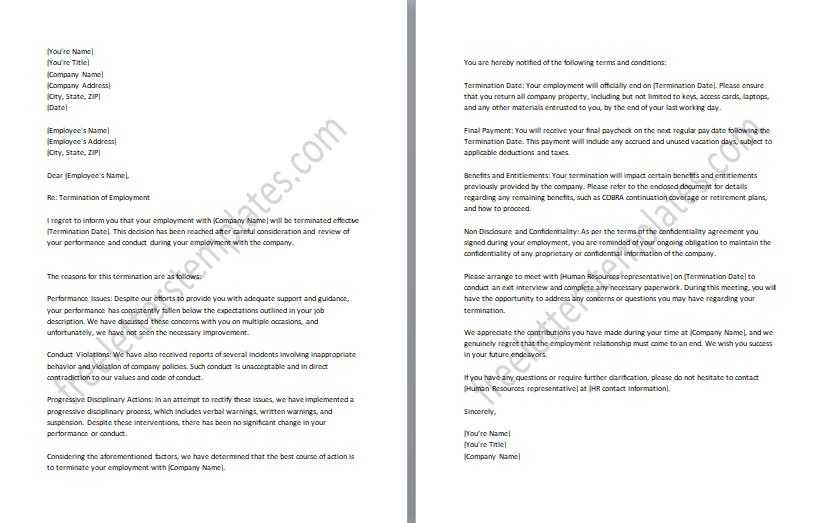
#2: Probationary Period Termination Notice
The Probationary Period Termination Notice is a written communication used by employers to inform an employee that their employment is being terminated during the probationary period. The notice specifies the date and provides a concise explanation of the decision. It may also outline any remaining obligations or requirements, such as returning company property. The purpose of this notice is to formally end the employment relationship and provide clarity to the employee regarding the decision during the probationary period.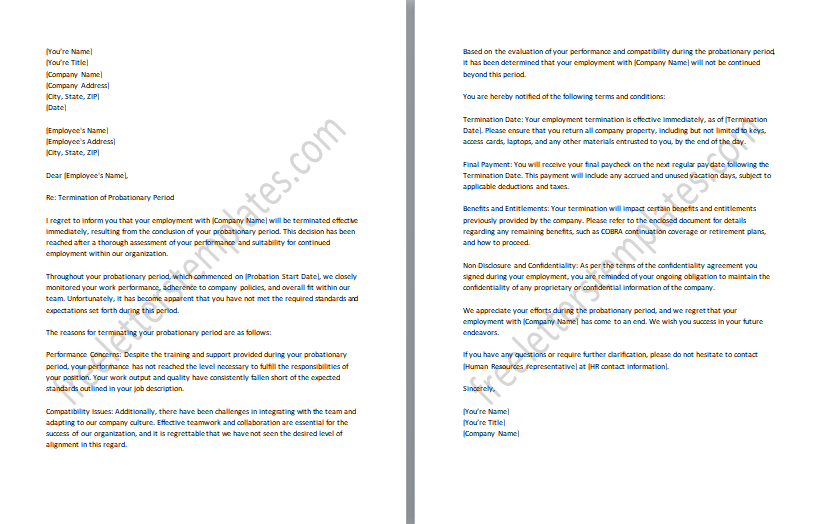
#3: Performance-Based Dismissal Letter
The Performance-Based Dismissal Letter is a formal document used by employers to notify an employee of their termination due to performance-related issues. It outlines the reasons for the dismissal, referencing specific instances or patterns of poor performance, and includes any prior discussions or warnings provided to the employee. The letter may also mention any performance improvement plans or opportunities that were offered but failed to yield satisfactory results. Its purpose is to communicate the employer’s decision to terminate the employee’s employment based on performance concerns and to provide necessary information regarding the process and any entitlements.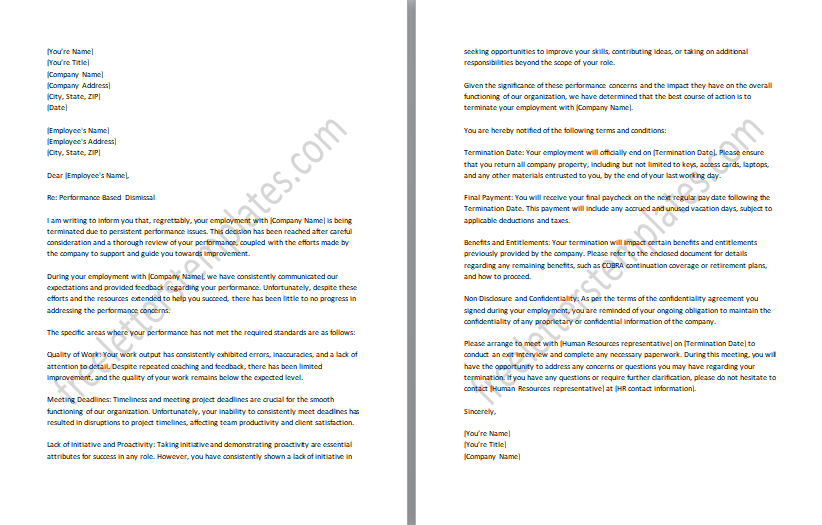
#4: Attendance Infraction Termination Notice
The Attendance Infraction Termination Notice is a formal letter issued by an employer to an employee informing them of their termination due to repeated attendance infractions. The notice highlights the specific instances of attendance violations, such as excessive tardiness or unexcused absences, and provides a clear explanation of the company’s attendance policy and expectations. It may also mention any prior warnings or disciplinary actions taken in relation to the attendance issues. The purpose of this notice is to notify the employee of their based on their attendance record and to provide necessary details regarding the process and any remaining entitlements.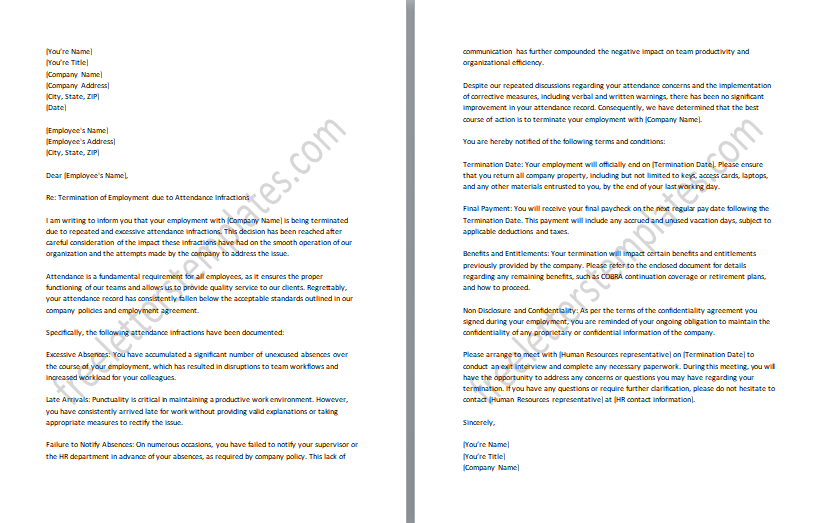
#5: Misconduct Termination Announcement
The Misconduct Termination Announcement is a formal communication issued by an employer to notify the team or organization about an employee’s due to serious misconduct. It highlights the violation of company policies and code of conduct without sharing specific details. The announcement informs employees of the termination, reaffirms the commitment to a respectful work environment, and emphasizes the importance of adhering to company policies. It underscores the employer’s dedication to a safe and professional workplace for everyone.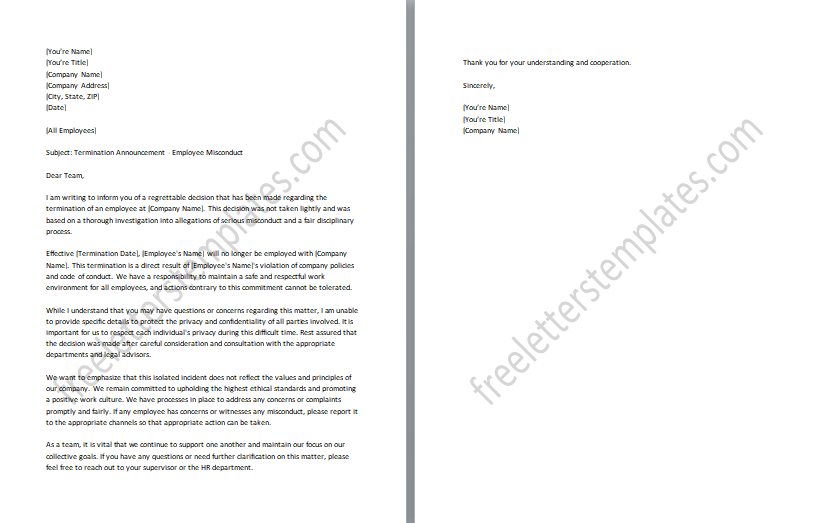
#6: Layoff Notification Letter
The Layoff Notification Letter is a formal communication sent by an employer to inform employees about their termination due to a workforce reduction. It announces the layoff, provides a brief explanation for the decision, and includes details such as the date and any severance or assistance programs. The letter aims to communicate the unfortunate necessity of the layoff, express gratitude for the employee’s contributions, and provide information on the next steps. Its purpose is to deliver the news of the layoff respectfully and transparently while offering support during this challenging time.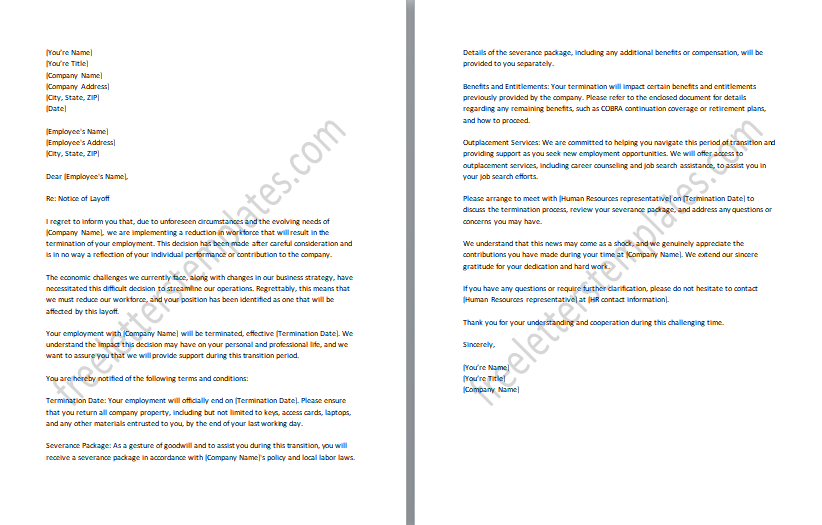
#7: Position Elimination Termination Notice
The Position Elimination Notice is a formal communication used by an employer to inform an employee that their position is being eliminated, resulting in their termination. The notice clearly states the reason for the termination, which is the elimination of the specific job role or position. It includes information regarding the date, any severance or assistance programs, and instructions for returning company property. The purpose of this notice is to formally notify the employee of the position elimination and provide necessary details and support during the transition period.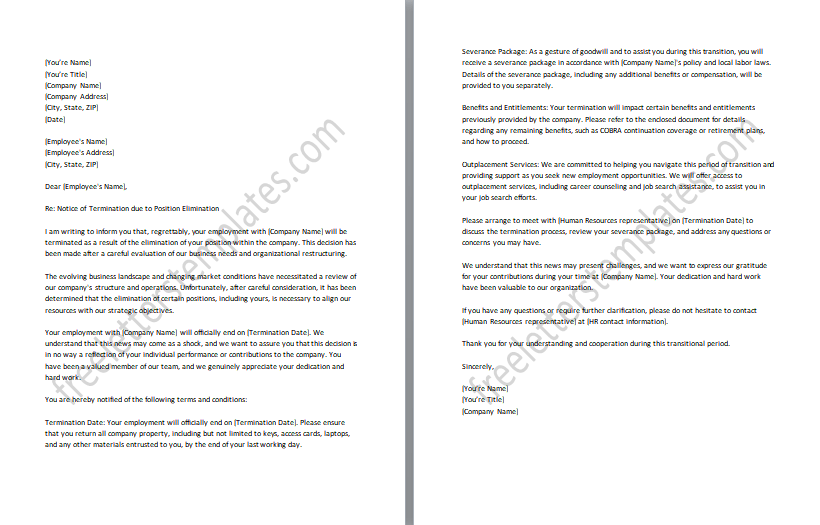
#8: Redundancy Termination Letter
The Redundancy Termination Letter is a formal communication issued by an employer to inform an employee about their termination due to redundancy. The letter explains the reasons for the redundancy, such as organizational restructuring or changes in business needs, and specifies the date. It may also provide information on any severance packages, outplacement assistance, or other support available to the employee. The purpose of this letter is to notify the employee of their redundancy and provide necessary details and resources to assist them during this transition period.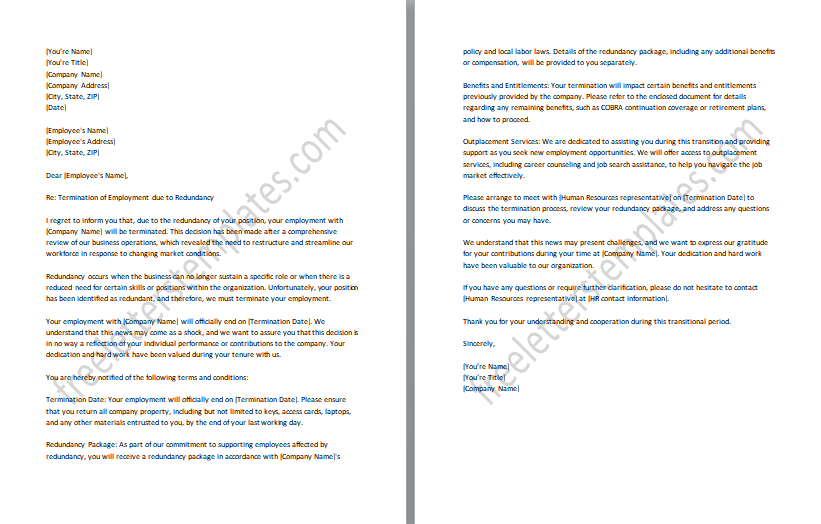
#9: Contract Termination Agreement
The Contract Termination Agreement is a formal document used to mutually terminate a contract between two parties. It outlines the terms and conditions agreed upon for the termination, including the effective date and any obligations or responsibilities that remain after termination. This agreement serves to legally end the contractual relationship and resolve any outstanding issues or disputes. Its purpose is to provide a clear and concise framework for both parties to dissolve the contract in a fair and mutually agreed-upon manner.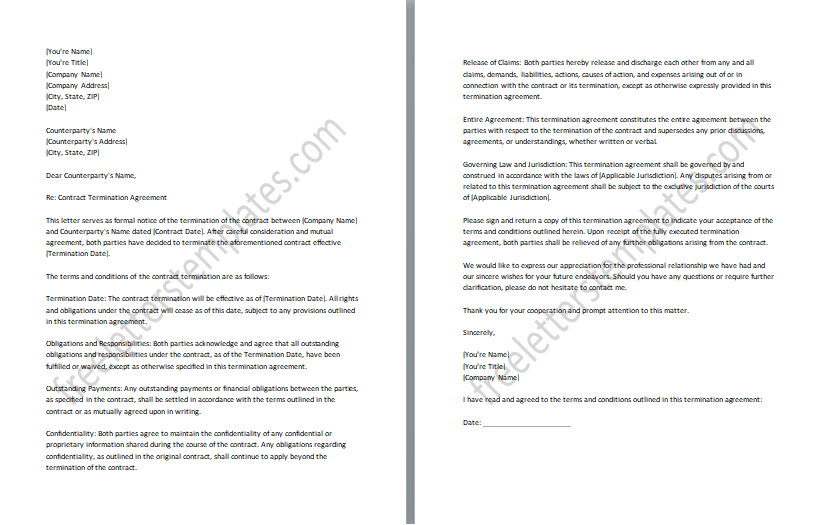
#10: Resignation Acceptance and Termination Confirmation
The Resignation Acceptance and Termination Confirmation is a formal communication issued by an employer to acknowledge and accept an employee’s resignation. It confirms the agreed-upon resignation date and acknowledges the employee’s decision to terminate their employment. The letter may also include details regarding the final paycheck, return of company property, and any remaining obligations. The purpose of this communication is to formally accept the resignation, confirm the date, and provide the necessary information to ensure a smooth transition for both the employee and the organization.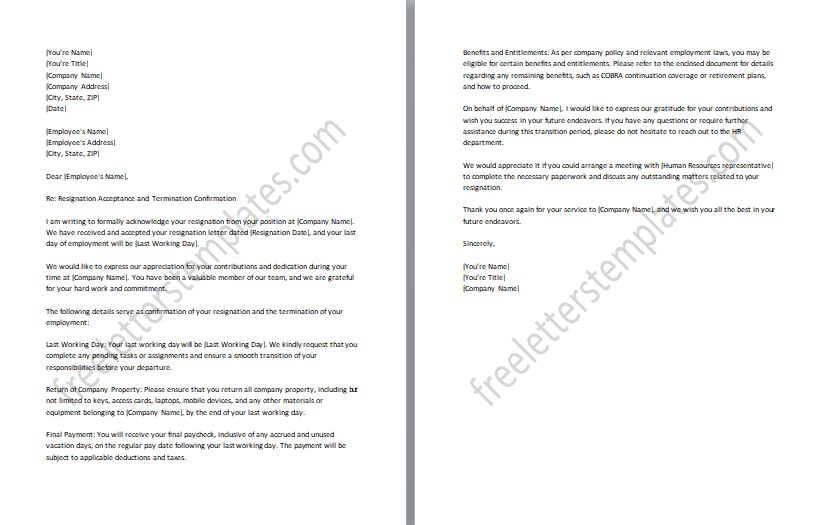
#11: Mutual Termination Agreement Notice
The Mutual Termination Agreement Notice is a formal communication used when both parties agree to mutually terminate a contract or employment agreement. It confirms the agreement to terminate, specifies the effective date and outlines any agreed-upon terms or conditions, such as severance packages or post-termination obligations. The purpose of this notice is to document the mutual decision to end the agreement, ensuring clarity and understanding between both parties involved.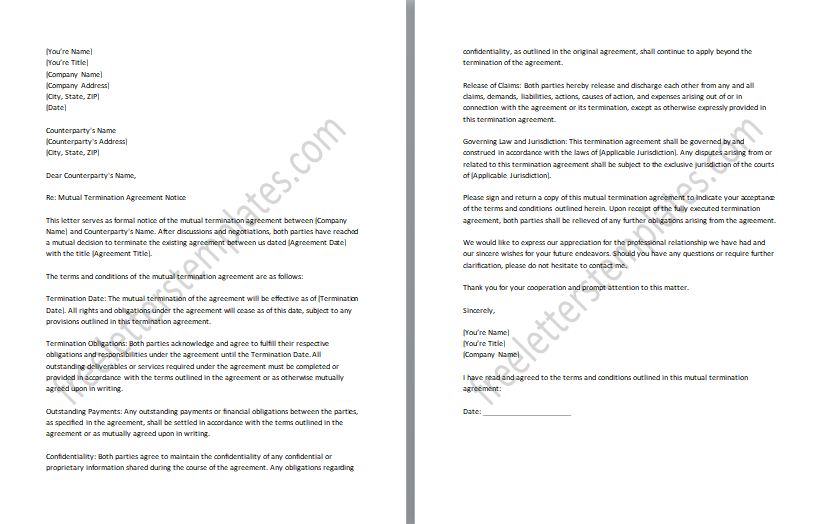
#12: Retirement Termination Announcement
The Retirement Termination Announcement is a formal communication issued by an employer to inform the team or organization about an employee’s retirement and the resulting of their employment. The announcement congratulates the retiring employee on their achievements and contributions to the organization, and it highlights their upcoming retirement date. It may also include details about any planned farewell events or celebrations. The purpose of this announcement is to celebrate the employee’s retirement, express appreciation for their dedication, and inform the team about the upcoming changes in the organization due to their retirement.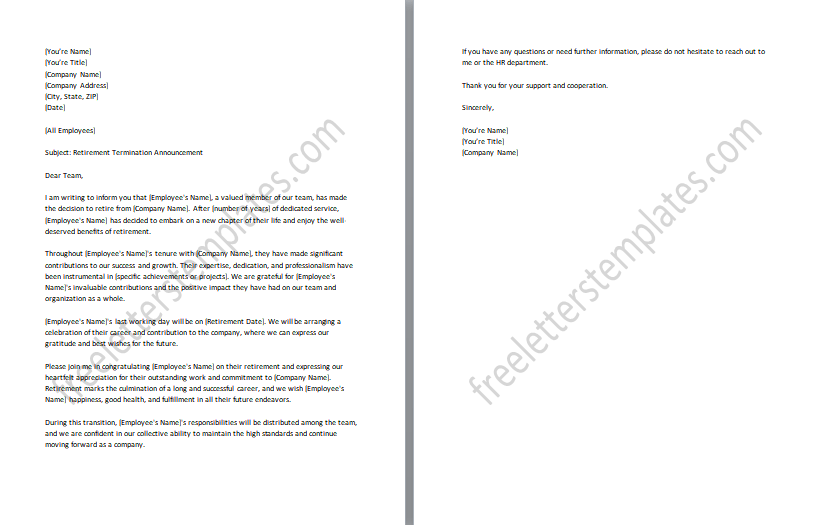
#13: Temporary Employment Contract Termination Letter
The Temporary Employment Contract Termination Letter is a formal communication used by an employer to end a temporary employment agreement before its agreed-upon expiration date. The letter states the decision to terminate the contract, specifies the effective date, and may include any relevant reasons or circumstances. It may also provide information on final payment, return of company property, and any remaining obligations. The purpose of this letter is to formally terminate the temporary employment contract and provide the necessary details and instructions to both parties involved.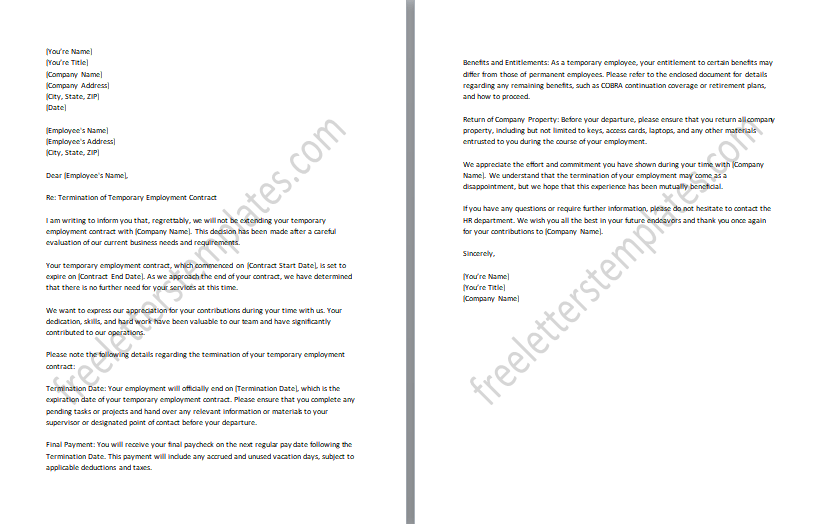
#14: Voluntary Resignation Acceptance Letter
The Voluntary Resignation Acceptance Letter is a formal communication issued by an employer to acknowledge and accept an employee’s voluntary resignation. The letter expresses acceptance of the resignation, specifies the effective resignation date, and may provide details on the final paycheck, return of company property, and any remaining obligations. The purpose of this letter is to formally accept the employee’s resignation, confirm the termination date, and provide the necessary information to ensure a smooth transition for both the employee and the organization.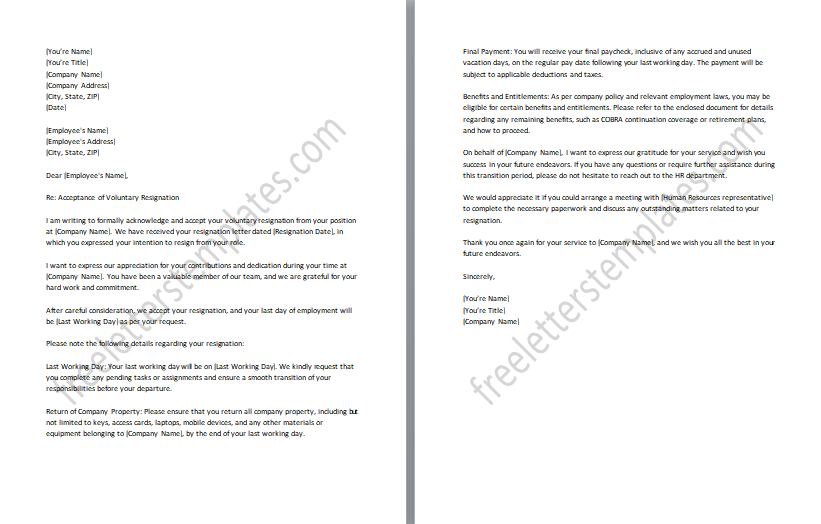
#15: Termination for Cause Notification
The Termination for Cause Notification is a formal communication issued by an employer to inform an employee of their termination due to a serious cause or misconduct. The notification clearly states the reasons for the termination, including the specific cause or misconduct, and may reference any prior warnings or disciplinary actions. It provides information on the effective date and any remaining obligations or requirements, such as returning company property. The purpose of this notification is to formally inform the employee of their cause and provide necessary details regarding the process.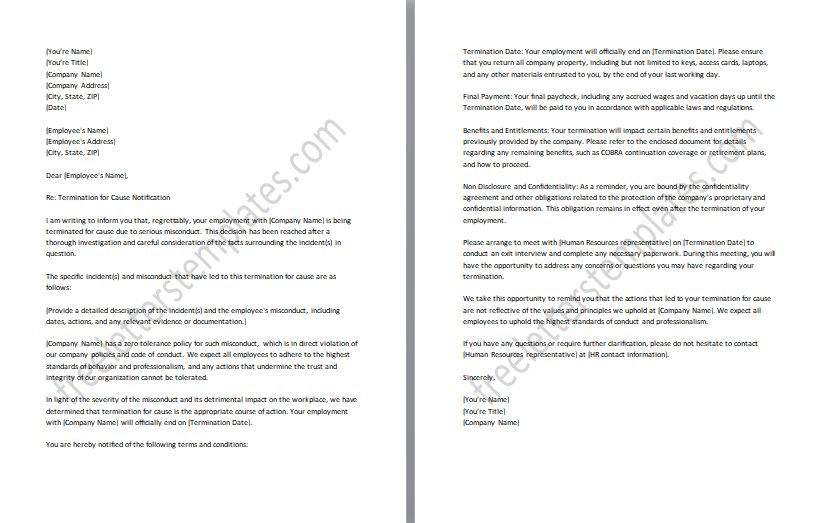
#16: Termination Due to Illness Announcement
The Termination Due to Illness Announcement is a formal communication issued by an employer to inform the team or organization about an employee due to prolonged illness. The announcement expresses regret, explains that the decision is based on the employee’s inability to return to work within a reasonable timeframe, and emphasizes the importance of the employee’s health and recovery. It may also provide information on any support available to the employee and remind colleagues to respect the employee’s privacy. The purpose of this announcement is to notify the team about the termination, express support for the employee, and maintain a respectful and compassionate work environment.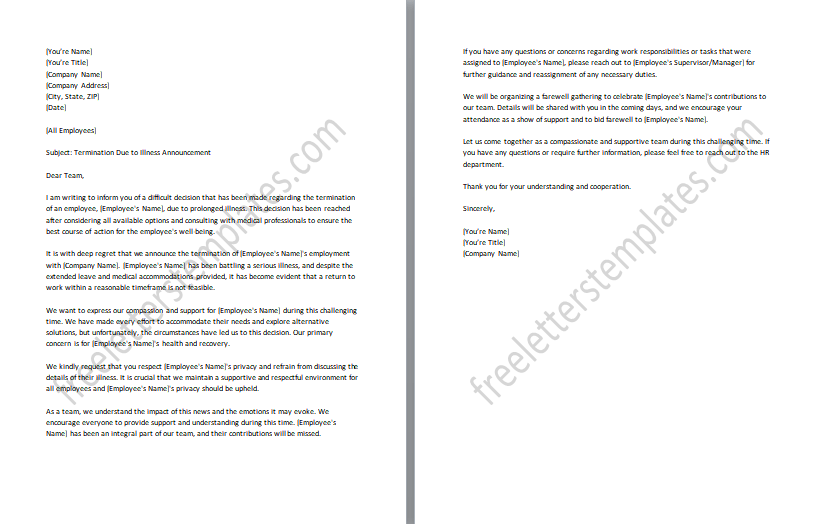
#17: Company Closure Termination Letter
The Company Closure Termination Letter is a formal communication issued by an employer to inform employees about the termination of their employment due to the closure of the company. The letter announces the closure, provides a brief explanation of the decision, and specifies the date. It may also include information on final pay, benefits, and any available assistance programs. The purpose of this letter is to formally notify employees of the company closure, express gratitude for their contributions, and provide necessary details and support during this challenging transition period.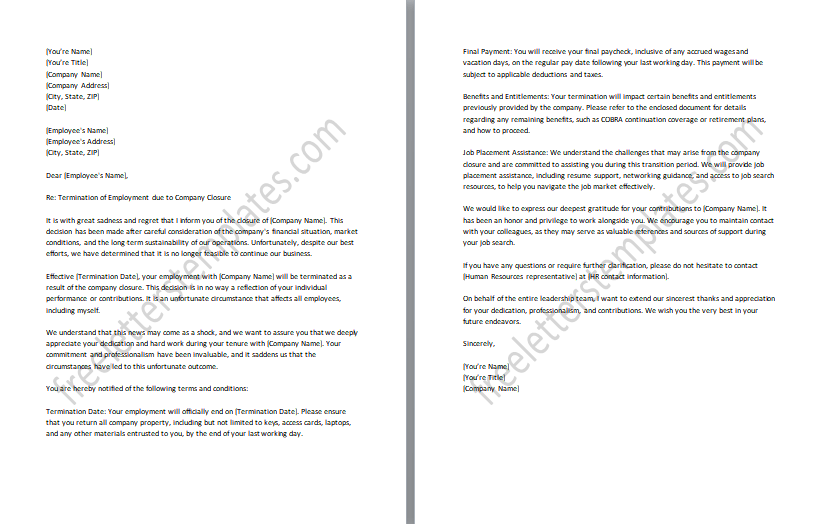
#18: Termination Due to Relocation Notification
The Termination Due to Relocation Notification is a formal communication issued by an employer to inform an employee that their employment is being terminated due to the relocation of the company. The notification states the reason for the termination, which is the inability or decision of the employee to relocate with the company. It specifies the date and may provide information on any available support or assistance for the employee during the transition. The purpose of this notification is to formally communicate due to relocation and provide the necessary details and resources to assist the employee during this period of change.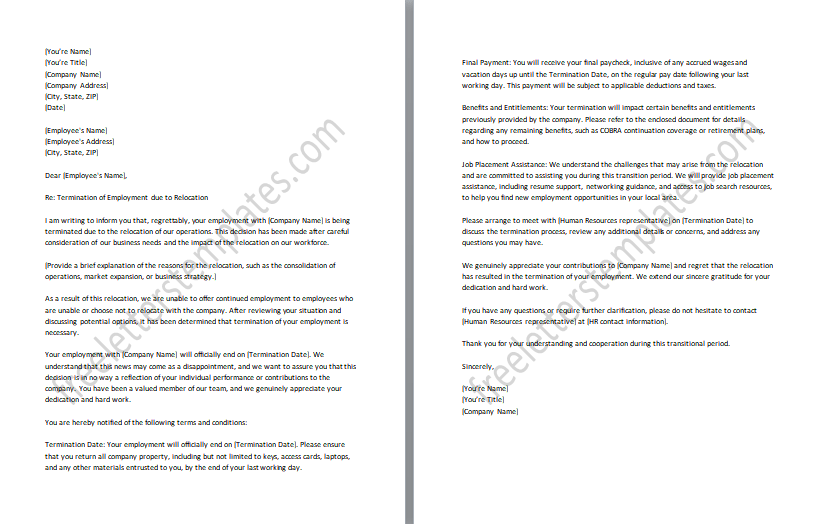
#19: Insubordination Termination Notice
The Insubordination Termination Notice is a formal communication issued by an employer to inform an employee of repeated acts of insubordination. The notice highlights the specific instances of insubordination, such as refusal to follow instructions or disrespectful behavior, and may reference any prior disciplinary actions. It specifies the date and provides information on returning company property. The purpose of this notice is to formally notify the employee of their termination for insubordination and provide necessary details regarding the process.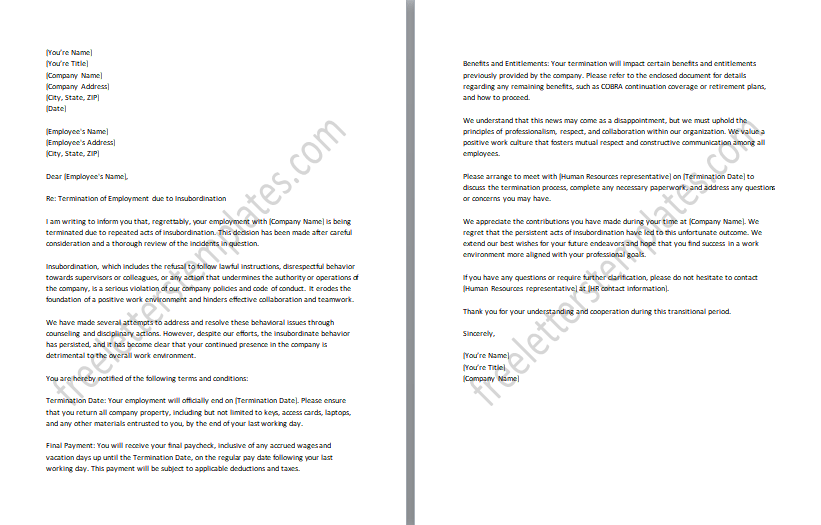
#20: Termination Due to Financial Constraints Announcement
The Termination Due to Financial Constraints Announcement is a formal communication issued by an employer to inform employees about due to financial constraints faced by the company. The announcement explains the financial situation, market conditions, or other factors leading to the decision. It states the date and may provide information on final payments, benefits, or available job placement assistance. The purpose of this announcement is to communicate the unfortunate necessity of the terminations, express gratitude for employees’ contributions, and provide necessary information and support during this challenging period.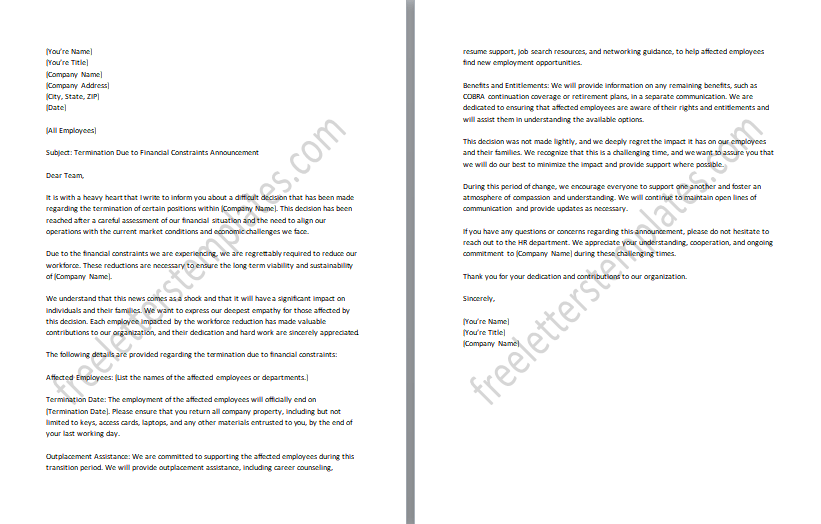
#21: Termination for Breach of Contract Letter
The Termination for Breach of Contract Letter is a formal communication used by employers to notify employees of their termination due to a significant breach of the employment contract. It states the breach, specifies the date, and may include supporting evidence. The letter also covers final payments, the return of company property, and remaining obligations. Its purpose is to formally terminate the contract, provide necessary details, and instruct the employee on the process.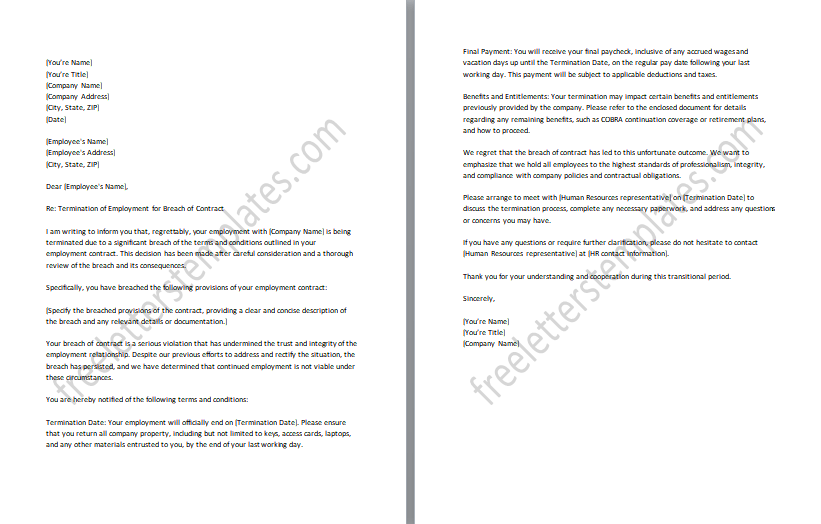
#22: Non-Disclosure Agreement Violation Termination Notice
The Non-Disclosure Agreement (NDA) Violation Termination Notice is a formal communication issued by an employer to inform an employee of their termination due to a serious violation of the non-disclosure agreement. The notice highlights the breach of the NDA, specifies the date, and may reference any prior warnings or disciplinary actions. It provides information on returning company property and may include reminders of the employee’s confidentiality obligations. The purpose of this notice is to formally notify the employee of their NDA violation and provide necessary details regarding the process.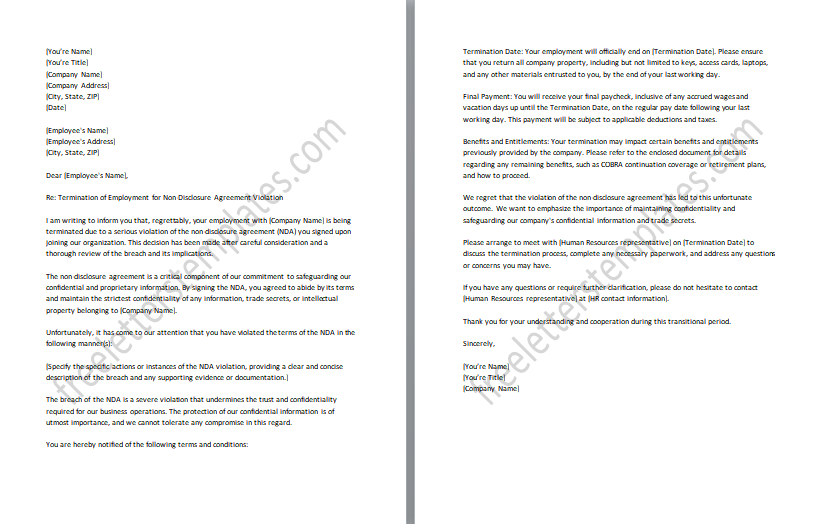
Common Reasons for Employment Termination:
- Poor Performance: Employment termination may occur when an employee consistently fails to meet job expectations and performance standards or fails to improve despite adequate support and feedback.
- Misconduct: Termination due to misconduct arises when an employee violates company policies, engages in unethical behavior, harassment, dishonesty, or any action that undermines the organization’s values and code of conduct.
- Layoffs: Layoffs occur when an employer needs to reduce its workforce due to financial constraints, economic downturns, or organizational restructuring. In such cases, terminations are not a reflection of individual performance but a necessity to ensure the company’s sustainability.
- Restructuring: Termination resulting from restructuring happens when a company undergoes organizational changes, leading to the elimination or consolidation of certain roles to optimize operations and resources.
- Voluntary Resignation: Employees may choose to resign voluntarily due to personal reasons, career advancement opportunities, or for work-life balance considerations.
- Contract Expiry: In cases of temporary or fixed-term contracts, employment may terminate upon contract expiration, provided there is no renewal or extension.
- Violation of Non-Disclosure Agreement (NDA): Termination may occur if an employee breaches the NDA by disclosing confidential or proprietary information without authorization.
- Absenteeism or Tardiness: Consistent and unexcused absenteeism or tardiness may lead to termination if it negatively impacts work productivity and team dynamics.
- Insubordination: Employees who display insubordination, refuse to follow instructions, or show disrespect towards superiors may face undermining the authority and harmony within the organization.
- Job Redundancy: Termination due to job redundancy occurs when an employee’s role becomes redundant or unnecessary due to technological advancements, process changes, or business shifts.
Following Legal Requirements in Employment Terminations:
- Severance Packages:
- Familiarize yourself with the relevant employment laws and regulations governing severance packages in your jurisdiction.
- Ensure that any severance offered to terminated employees complies with these laws and is provided in accordance with the terms of the employment contract, if applicable.
- Clearly outline the terms and conditions of the severance package in a written agreement to avoid misunderstandings.
- Notice Periods:
- Understand the notice period requirements mandated by employment laws or stated in the employment contract.
- Provide advance notice to employees before termination, as required by law or contract, to allow them time to prepare for the transition.
- If immediate is necessary, follow any legal exceptions that may apply.
- Termination Documentation:
- Keep thorough and well-documented records of the process, including any performance issues, warnings, or disciplinary actions taken leading up to the termination.
- Document the specific reasons for the termination to demonstrate compliance with employment laws and to justify the decision if questioned later.
- Employee Rights and Benefits:
- Ensure that terminated employees receive all entitlements they are legally owed, such as final pay, accrued vacation days, and benefits continuation, as per employment laws and company policies.
- Provide information and guidance to employees on accessing unemployment benefits or any other assistance available to them after termination.
- Non-Discrimination:
- Avoid terminating employees based on protected characteristics, such as race, gender, religion, age, disability, or national origin, as this constitutes discrimination and may lead to legal repercussions.
- Base decisions solely on legitimate business reasons, supported by evidence and documentation.
- Compliance with WARN Act:
- If conducting a mass layoff or plant closure affecting a significant number of employees, comply with the requirements of the Worker Adjustment and Retraining Notification (WARN) Act, which mandates advance notice to affected employees and relevant government agencies.
- Consult Legal Experts:
- When in doubt about legal requirements or handling complex employment terminations, seek advice from legal experts experienced in employment law.
- Legal consultation can help ensure that your process aligns with the law and minimizes potential legal risks.
Concluding Thoughts:
Navigating employment terminations is a challenging and sensitive process that requires careful consideration of legal requirements, as well as empathy and professionalism. We understand the significance of handling employment with respect and compassion. Our website “Employment Letters” aims to provide valuable resources and guidance to employers facing decisions, ensuring they are well informed about the legal aspects, best practices, and practical approaches to termination.
We emphasize the importance of compliance with employment laws and regulations, such as severance packages, notice periods, and documentation, to protect both employees’ rights and the company’s interests. By following ethical practices and maintaining open communication, we strive to create a positive and supportive environment during these challenging times of change.